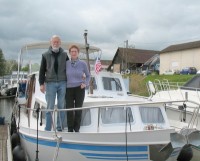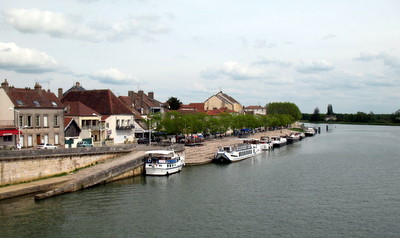As anticipated, it took a couple of days to sort out our living spaces. The books were in the food compartment, the bedding on the kitchen table, and the gangplank was in the aft cabin bedroom. Luckily the weather was good, so we could open up the entire boat and move things from area to area, including the outside decks and pontoon to which the boat was tied.
 While I did the unpacking, Neil focused on getting some of the domestic systems working. That’s when he found out what he would be doing for the next week: the engine batteries were dead, the toilet didn’t function, and the water pump for supplying water from our on-board tank needed replacing. But I’ll let him tell you that story later.
While I did the unpacking, Neil focused on getting some of the domestic systems working. That’s when he found out what he would be doing for the next week: the engine batteries were dead, the toilet didn’t function, and the water pump for supplying water from our on-board tank needed replacing. But I’ll let him tell you that story later.
Every year when we leave I do an inventory of what we are leaving on board for the winter: clothing, bedding, first aid supplies, etc. But somehow my memory of what’s there, what the inventory indicates, and what is actually there – and its condition – don’t quite match up. This year the critical mismatch has been warm weather clothing, and slacks for me that fit. We had never arrived in April before and, though the afternoons have often been warm, the morning temperatures have ranged from 10-15 degrees C (in the 50’s F) – inside the boat! Luckily, we were able to find a small, oil filled, electric radiator to warm things up. Unfortunately, our fleece jackets didn’t make it into the suitcase. Neil says it can be “a toughening up process.” I just admit I’m cold.
After getting things in place, more or less, I then needed to focus on provisioning the kitchen and making sure we had some of the basics, e.g. lots of paper towels, toilet paper, etc. Luckily, there is both a Casino (grocery store) and an Intermarché store within about a 10-15 minute walk of the marina. So, I headed out with my trusty Dutch shopping cart.
 A couple of days later, Elizabeth, from the boat tied up next to ours, asked if I’d like to do a more serious shopping with her. And she had a car. What luck! Then I could replenish our heavy supplies: boxed milk, juice, water, beer, and wine – plus some canned goods. British and German boaters frequently bring their cars with them for the cruising season. They leave the car at their first port with a train station nearby, cruise down the canal or river for several days, then return by train to retrieve their car. It seems to be a bit of a hassle at times, but certainly simplifies grocery shopping and touring to places without train or bus stations.
A couple of days later, Elizabeth, from the boat tied up next to ours, asked if I’d like to do a more serious shopping with her. And she had a car. What luck! Then I could replenish our heavy supplies: boxed milk, juice, water, beer, and wine – plus some canned goods. British and German boaters frequently bring their cars with them for the cruising season. They leave the car at their first port with a train station nearby, cruise down the canal or river for several days, then return by train to retrieve their car. It seems to be a bit of a hassle at times, but certainly simplifies grocery shopping and touring to places without train or bus stations.
Each year we connect with old friends and make new ones. With boaters, you are seldom sure who will pop up when. During the first week, we met Scots, English, and Americans. Each new friendship called for getting to know each other over several glasses of wine. Interestingly, the most unique connection was meeting an American couple. There are many Americans who boat for a week or two, renting a boat or staying on a hotel boat. But we rarely meet other Americans cruising on their own boats. British, Dutch, Germans, Australians, and New Zealanders typically populate the French canals and rivers. The French have traditionally thought of their canal system as a means of transporting freight, but are slowly coming to recognize the recreational possibilities.
For over eight years, Neil and Joan have been spending their summers cruising the canals and rivers of Western Europe aboard their now thirty-year-old Dutch motor-cruiser, the “Estate.” This year they are sharing their experiences.


Comments